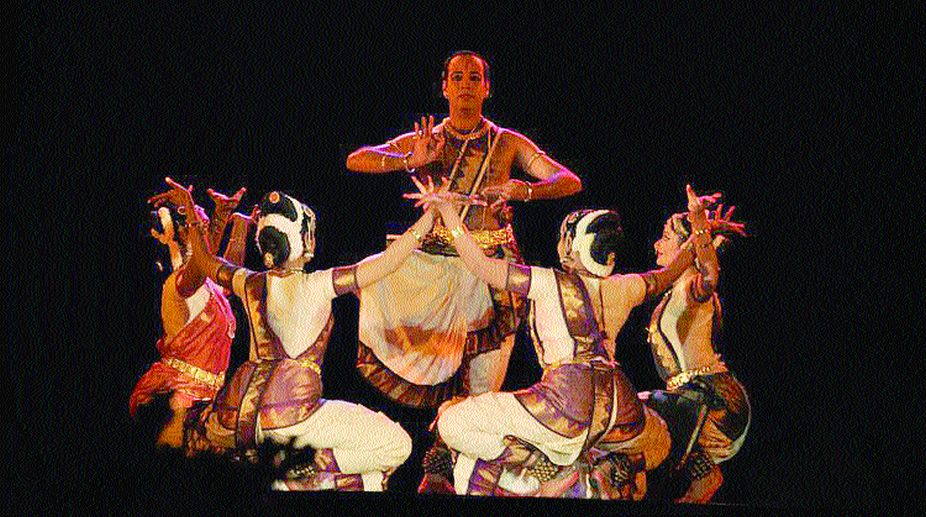Remembering Rukmini Devi
Thanks to Kathak exponent Ashimbandhu Bhattacharya and his team consisting of Avik Chaki and Subroto Pandit, rasikas got a glimpse of their excellent Kathak rendition.

Madras Music Academy’s festival of dance saw performances from some of the very best and their exceptional choreographic works.
Bharatanatyam dancer Malavika Sarukkai was conferred the title of Natya Kala Acharya by the Academy and she performed on the fourth day of the seven-day-long festival. She began with Trayodhbhavam in ragam revagupti in misra chapu talam to a musical composition of Tansen on CV Chandrasekhar’s choreography. Next up was the Varnam piece, Sami ninne korinanura by Ponniah Pillai of the Tanjore quartet. As the nayika, Sarukkai entreated the resident of Tanjapuri, her lord, to accept her and create a beautiful moment with rasanubhava. Possessed with stunning stage presence, the varnam, imbibed with care, was rendered in the beautiful vocabulary of Bharatanatyam. Vocalist Murali Parthasarathy, violinist Srilakshmi Venkataramani and flautist JB Srutisagar created a beautiful atmosphere with their acoompaniment along with mridangist Nellai A Balaji.
Leela Samson, a name to reckon with in the field of Bharatanatyam, started with Ambal Poothavale Viruttam. She performed the legendary varnam, Sami neeve in Telugu by the Tanjore quartet. Excelling both in the nritya (dance) and abhinaya (acting) portions, Samson was at her best in Nibhrite Nikunje, where Radha urges her Sakhi to bring back Madana to her. She recalls her moment of togetherness with him in the subtlest way possible — that, an erotic poem could be so sublime, was to be seen to be believed. She was just awe-inspiring and the audience was left spell-bound. Adith Narayan’s nattuvangam was flawless. Vocalist Radha Badri and mridangist Kartikeyan Ramanathan wove magic as did Ananthakrishnan, the violinist.
Advertisement
Adith Narayan was again the nattuvanar of Kuchipudi mentor Jaikishore Mosalikanti and his group who presented Ananda Nartana of Ganapathim composed by Oothukadu Venkatakavi in a superb choreographic work. After that was Jatiswaram in ragam atana and adi talam composed by Bokka Appaya Sastry with the finest jathis in the Kuchipudi style of Vempati Chinna Satyam. Narayana Teertha’s Tarangam with the music composition of Sweta Prasad was savoured by rasikas with great relish. Purandaradasa’s Arathi was another highlight. The lead dancers, Jaikishore and his wife Padmavani, were superb. Chitra Visveswaran’s disciple Jai Quehaeni was among the upcoming dancers who performed in the morning slot. She has been nurtured with care by her guru and Quehaeni passed the acid test of rendering the varnam, Sakhiyae nee reasonably well. Her abhinaya in the padam, Netrandi Nerathile was promising. Visveswaran herself was the nattuvanar.
Bharatanatyam performer P Praveen Kumar, who has honed his skills from the veteran gurus Narmada and CV Chandrasekhar, created an instant rapport with the audience with the varnam, Vadane Navaneeta Gandha in ragam hindolam and talam adi. Description of the clever Krishna, who does many things behind the back of his mother and the gopis — so much so that he doesn’t mind swearing too — was portrayed sweetly. Delineation of his komala tandava nritya was endearing and beautifully emoted by the dancer. He did receive a standing ovation. In the padam by Subramaniya Bharatiyar in ragam malika aditalam, Praveen was the hero waiting for his beloved who did not turn up. This was quite unusual because it is usually the other was round.
Vaibhav Arekar was, by far, one of the very best this season. An alumnus of the Nalanda Nritya Kala Mahavidyalaya with a Master’s in Bharatanatyam, he has been meticulously trained in the art of abhinaya and choreography by Kanak Rele. As the lead performer of the Nalanda troupe, Arekar presented a magnificent performance. Through Sribighnarajam Bhaje in ragam gambhira natai and talam khanda chapu, a composition of Oothukadu Venkata Subayyar, he established himself within the wink of an eye. The audience gasped! What balance, they went! With the line Sri Vigna rajam bhaje, he covered the whole stage dancing with ease and élan.
Dani in ragam vasanta and mishra jhamba talam by Ramanathapuram Srinivasa Iyengar used a complex idiom. Arekar confessed that his was a collaborative effort with nattuvanar Kalishwaran Pillai along with vocalist Srikanth Gopalakrishnan, mridangist Satish Krishnamurthy, violinist Easwar Ramakrishna and of course flautist, JB Sruthi Sagar. His adavus and korvai were polished to shine.
The sloka subhashita based on hasya rasa was the choreographic work of Rele. Shiva was deep in meditation when his companions announced the coming of Vishnu. Shiva hatched the plan of donning the tiger skin and fastening it with the snake that was around his neck.
The two gods greeted each other with sophistication, but for the fact the frightened snake fled on seeing Vishnu’s vahana, Garur. There was much comedy in this piece. Eka aarohana nandi was taken from the 16th century works of Bhakta Ekanath Maharaj who preached through his abhangs that the Shaiva god and the Vaishnava god are both one and the same.
Arekar did a lot of thinking before abandoning himself to performing the purviragan thillana of Vaidyanatha Bhagavatar in rupakam talam. Fresh thinking went into the composition of this thillana, which made it unique in its own way. His performance practically swept the audience off their feet.
The premier institution Kalakshetra founded by Rukmini Devi Arundale presented Choodamani Pradanam choreographed by Arundale herself. The music composition was by Vadudevacharya. In their search for Sita, the two brothers Rama and Lakshmana reach Lake Pampa surrounded by a forest. Rama gets emotional and Lakshmana consoles him. The next scene was their travel to Mount Rishyamukha in search of Sugreeva, the exiled lord of the monkeys. Hanuman reaches the brothers in the garb of a mendicant, to confirm if they had been sent by Sugriva’s evil brother Vali. The story continued to include the episode where Hanuman reaches Lanka and manages to speak to Sita and give her Rama’s ring and bring Sita’s Choodamani to him. The story was enacted with both dance and abhinaya by the artists of Kalakshetra
Advertisement